Claim Center
We're in the business of helping people, providing prompt and personal claims service when you need us the most.
Call 877-242-2544 anytime, day or night, to report claims. You may also contact your independent agent to report a claim.
- Personal & Business ClaimsLearn More
- Life ClaimsLearn More
- Workers' Compensation ClaimsLearn More
Plan & Protect
Reduce risks and enjoy peace of mind with these tips and insights to protect what matters most.
Give Your Chimney a Clean Sweep

Relax and enjoy a fire in your fireplace after annual maintenance.
Fireplaces, chimneys and flues account for a significant number of home heating fires each year, according to data from the Consumer Product Safety Commission. Homeowners with a wood-burning fireplace or solid fuel stove or insert can protect your property and your family by having a qualified professional inspect and clean your chimney at least once per year.
Maintaining a chimney through an annual inspection and cleaning is critical for fire safety, especially as winter approaches and temperatures drop. The buildup of chimney deposits is a major factor in most chimney fires. Creosote, a tarry residue caused by incomplete combustion of wood, can build up in chimneys and ignite a chimney fire when the internal temperature of a chimney flue becomes very high, especially during times of extended use during persistently cold temperatures.
Tips for a Safe Winter Fire Season
Burn only seasoned wood.
It burns cleaner and can help avoid creosote buildup within the flue.
Do not overload the firebox.
Stack logs only up to half the height of the opening. Flames should never reach up into the chimney.
Do not burn wrapping paper or boxes in the chimney.
These materials can contribute to flue creosote buildup.
Build smaller fires using hotter burning woods like hickory or ash.
These woods burn more completely and leave fewer deposits.
Keep an inch of ash on the bottom of the firebox.
This allows the coals to nestle down and cool off at the end of the burn.
Watch the duration of your fire.
Factory built fireplaces are designed with thinner sheet metal and may not be able to withstand an all-day fire. On very cold days, consider building a fire intermittently throughout the day.
Keep valuable items away from the fire.
Avoid putting expensive artwork, precious family photos or other collectibles on the mantel, hanging above or on adjacent bookshelves.
The United States Fire Administration recommends that chimneys be inspected at least once a year and cleaned as necessary. However, a chimney and flue system is a complicated mechanical system that requires regular inspections, just as HVAC systems, plumbing systems and electrical systems do. The inspection and cleaning of a chimney is a specialized job and should be performed by certified professionals.
This loss control information is advisory only. The author assumes no responsibility for management or control of loss control activities. Not all exposures are identified in this article. Contact your local, independent insurance agent for coverage advice and policy service.